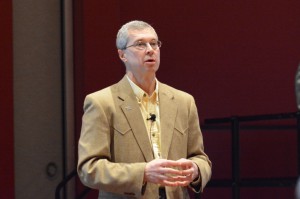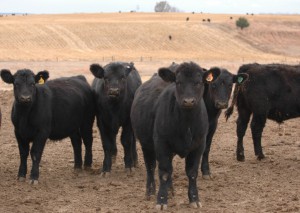
No bidders
Have you ever asked a cattle feeder if he had career aspirations of being a veterinarian?
Mark Hilton, of Purdue University, says he has yet to meet one who dreams of spending his days treating cattle.
 “They hate having sick calves. They want to have healthy calves,” says the veterinarian.
“They hate having sick calves. They want to have healthy calves,” says the veterinarian.
At his Cattlemen’s College session last month, I heard Mark present a pretty convincing case for preconditioning (a 11-year analysis of Indiana producers showed a profit of more than $80 per head, on average for 60+ day programs, for example).
But it wasn’t just about the economics of it all. It was about the principle.
“I’m a low-medicine veterinarian,” he says. “I want to use management instead of medicine and money.”
One of the best ways to ensure health during one of the most stressful times in calves’ lives is to precondition. What’s better for the animals is better for the owners. Less sickness=less labor. It’s better for the next person in line, too.
Mark did a quick poll: “How many of you who sell calves want that feedlot guy to make a pile of money on your calves?” Hands shot up all over the room. Everybody wants their cattle to do well for the next person in line.
Of course, cattle feeders have a role in all this, too.
 “When you buy preconditioned, high-quality calves you’re telling the beef industry that producers of preconditioned, high-quality calves are your partners. When you’re buying high-risk calves, you’re telling the industry that you’re going to take advantage of somebody,” he says.
“When you buy preconditioned, high-quality calves you’re telling the beef industry that producers of preconditioned, high-quality calves are your partners. When you’re buying high-risk calves, you’re telling the industry that you’re going to take advantage of somebody,” he says.
Mark introduced a plan to rid the industry of unweaned, co-mingled, high-risk cattle: “Every buyer of feeder calves agrees not to bid on high-risk calves. As the auctioneer goes down and down in price, ‘$2.80, $2, $1.50, 23 cents? Sorry, boys, no takers. Take them back home.’ In 30 days you think that would change the industry?”
That got a lot of chuckles, but the reality is that IS happening in a much slower fashion across the countryside. Take a look at any salebarn study or video auction analysis and it will show the advantages for preconditioned, reputation calves (or the discounts for the opposite).
What side of that equation do you want to be on?
Just something to think about while you’re pondering the year ahead during those late-night calving checks.
May your bottom line be filled with black ink,
Miranda
You may also like
A Drop of Hope, A Heap of Hard Work
For Manny and Corina Encinias’ family of nine, sustainability runs deep. They are stewards of a legacy, working the land dating back to 1777, when the first generation began herding sheep in the nearby Moriarty community. Today they focus on cows well suited to the harsh New Mexico desert, fostering community strength and creating opportunities for others to follow in their footsteps.
Going Above and Beyond
It’s a normal day near Hudson, Colorado for the Walter family, yet the view is uniquely awe-inspiring for visitors who have never stepped foot on a ranch. As cows come in closer visitors take in the far-reaching pastures and breath-taking mountain views. For the Walter Family, there’s no better backdrop to introduce people to the place where beef begins.
Progress, Not Perfection
It’s a labor of love, obvious in the way she lights up explaining their family’s 33-year effort to proactively adapt Angus cows to their land. A lifetime of telling stories from the pasture or kitchen has resonated with nonfarm consumers as much as fellow ranchers. “Everything we do is about cattle, but it’s also about family and connecting our kids to the land and to the cattle,” Debbie Lyons-Blythe says.



